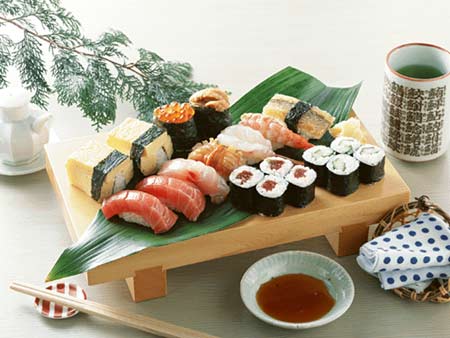一提到壽司就會聯想到日本?其實壽司的起源是在中國!壽司中含有豐富的維生素和微量元素,是風靡世界的健康食品。整塊壽司要一口吃下,那飯香與生魚片的香味完全相融,將齒頰間填得滿滿,不留一絲縫隙,那濃香的滋味無處可逃,在口中久久徘徊;壽司不僅僅是食物,它更是精妙的藝術。魚生的美麗、色彩的和諧以及充滿創造力的拼盤組合,使你光看到它們就已胃口大開!

By Renee Dietz
卓言 選譯
|
Sushi has a very interesting origin that has lasted for centuries and continues to be a very popular food today. Sushi is made with a combination of shellfish, cooked or raw fish, vegetables, and seasoned rice. Although Sushi is most commonly linked to the Japanese heritage, it actually began in China during the 7th Century. At that time, any fish caught had to be preserved. The only method possible was by fermentation. Raw fish was cleaned, filleted, and then pressed between layers of heavy salt and usually weighted down with some type of stone. The fish would remain this way for weeks at which the stone would be removed and then replaced with some type of light cover. The fish would stay in the salt layers for a couple of months until the fermentation process was complete. Over time, a discovery was made that by rolling the fish in rice that had been soaked in vinegar the fish was fermented in a matter of days rather than months. The rice was then tossed out and the fish eaten. However, with drought and a food shortage, people began consuming the rice as well as the fish and thus, Sushi as we know it today was born. However, in the 1800s, a famous chef by the name of Yohei was planning a large dinner party. Finding that he had not set out enough fish to serve his guests, he took a piece of fish from the freezer that had not been fermented and decided to take his chances in serving it. What he found was that frozen fish actually retained their flavor and any bacterium was killed. From this discovery, Yohei created two styles of Sushi —one called Edo, and the second, Osaka, for the city. Sushi is usually consumed with hot green tea. Gari (thin slices of vinegar pickled ginger root) is offered free and eaten between bites to freshen the palate. Two kinds of sauces are usually available: one is soy sauce, which is poured on most kinds of sushi; the other is a thick sweet sauce used on eel. Wasabe (hot, green Japanese horseradish) can be added to make it spicier. Sushi has taken the world by storm and today is a multi-billion dollar industry. The popularity of Sushi continues to rise in that people are looking for healthy food that is quick and easy to make. With such incredible popularity as well as the health benefits of eating Sushi, it is likely that this food will continue to be a part of everyday life for many more centuries to come. |
壽司有著非常有趣的起源,它流傳了數百年,直到如今仍然是非常受歡迎的美食。壽司是由貝類、熟魚或生魚、蔬菜以及調過味的米飯混合而成的佳肴。盡管壽司大都被認為與日本有著千絲萬縷的淵源,但實際上早在7世紀時,它起源于中國。 在那個年代,所有捕來的魚都要被貯存起來,唯一可能的貯存方法就是發酵。生魚被清洗干凈、切成片,然后用一層層厚重的鹽給壓起來,通常再壓上某種石頭。生魚會以這種方式被保存數周,之后,石頭被移走,轉而壓上一些較輕的覆蓋物。接著生魚在鹽層中被保留數月,直到發酵的過程完成為止。 隨著時間的推移,人們發現可以把魚肉卷在醋浸過的米飯中,和以往那種發酵幾個月的方式比起來,這種方法僅用數天就可以發酵完。米飯則被扔掉,留下魚肉食用。然而,由于旱災和食物短缺,人們在吃魚的同時也開始連同把米飯都吃掉,于是,我們今天所熟知的壽司便誕生了。 但到了19世紀,一位名叫洋平的著名日本廚師正在籌辦大型的晚宴時,發現自己沒有準備出足夠多的魚來招待客人們,于是他便從冷藏庫里取出一方未經發酵過的魚肉,決定碰碰運氣,就用它來招待客人。他發現冷凍過的魚肉居然保留住了其本身的味道,而細菌則都被殺死了。基于這一發現,洋平發明了兩種壽司:一種叫做江戶壽司,另一種叫做大阪壽司,因大阪這座城市而得名。 壽司往往和熱乎乎的綠茶一起搭配食用。(餐館)會供應免費的Gari(即細條、醋腌的生姜),在每口之間食用,用來提鮮。一般有兩種醬汁佐用:一種是醬油,可以倒在大多數種類的壽司上調味;另一種是濃稠的甜汁,用于搭配鰻魚壽司食用。山葵(一種綠色的日本辣芥末)可以使壽司的味道更辛辣。 如今,壽司已經風靡全球,更成為了一個銷售額達數十億的產業。壽司因其健康以及易做的特性而受到越來越多的人的追捧。 由于壽司的大受歡迎和食用它所帶來的健康益處,這種食物可能會在將來的數百年里繼續風行下去,成為人們日常飲食的一部分。 (來源:英語學習雜志) |
|
Vocabulary: 1. fillet 把(肉、魚)切成片 2. consume 吃,大口吞下 3. bite 一口食物,少量食物。壽司多講究一口一個 |